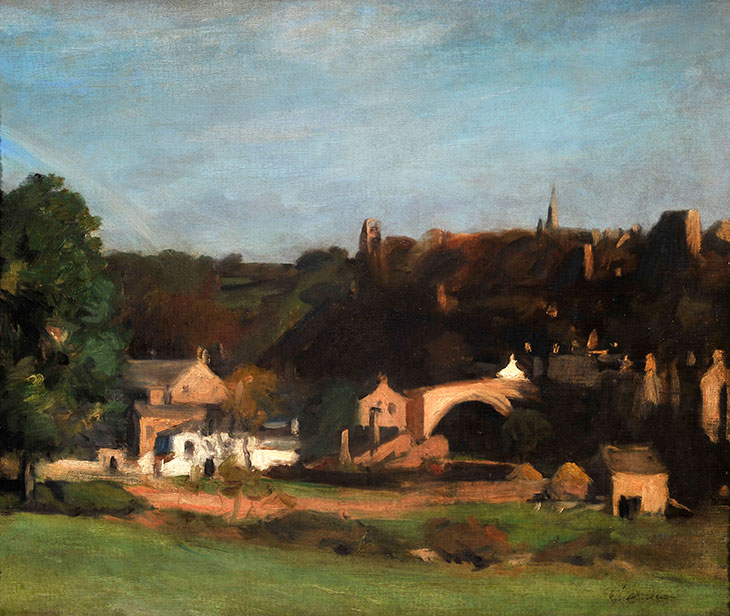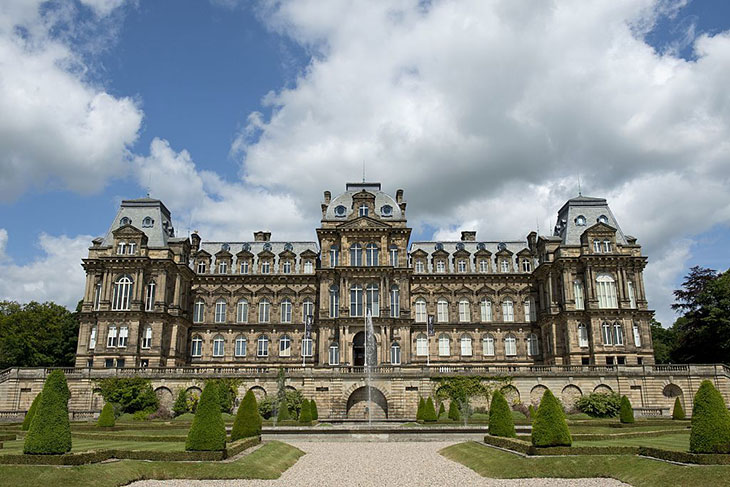As we are currently reminded, Barnard Castle – on the border of County Durham and Yorkshire – is some 250 miles north of London. J.M.W. Turner visited this celebrated beauty spot in about 1825 during his Yorkshire tour and painted the ruined 12th-century Teesside castle. Seventy years later, in 1896, the young Philip Wilson Steer, inspired by Turner’s example, headed north to visit the picturesque town. Steer’s frequent travelling companion was the artist Fred Brown, co-founder of the New English Art Club in 1886 and, from 1893, professor at the Slade (Steer’s drawing of Brown from 1894 is in the National Portrait Gallery). During their stay, Brown visited the newly established Bowes Museum, adding his name to the visitors’ book on 19 August 1896. Steer’s painting of Barnard Castle from the banks of the river, acquired by my parents in the 1960s, hung above their drawing room mantelpiece in South Kensington until 2008. My mother Barbadee Meyer, a keen artist, admired Steer’s observation of the quality of northern light and the unusual aspect, which focused on the town’s industrial heritage.
A View of Barnard Castle, Yorkshire, from the River with Carpet Mills (1896), Philip Wilson Steer. The Bowes Museum, Barnard Castle

In 1975 I accompanied my Francophile parents on our first visit to Barnard Castle; we were bowled over by the imposing and unexpected chateau designed by the French architect Jules Pellechet for John Bowes and his French wife Joséphine Coffin-Chevalier to house their extensive collection of paintings and decorative art for local public benefit (the Bowes Museum opened its doors in 1892, seven years after John Bowes’s death in 1885; Joséphine had died in 1874). Twenty years later, returning as furniture curator at the V&A, I was able to appreciate the range and the depth of the collections. Following Sarah Medlam’s research for the Bowes Museum’s exhibition on local carpet manufactories in 1996, the significance of Steer’s townscape became clear. The mill buildings in the foreground, powered by the river, housed carpet manufactories established after the Napoleonic Wars during the depressed 1820s with funds provided by local Methodist businessmen. In 1851, when the local industry employed 365 people of a 4,500-strong population, Joshua Monkhouse, one of three proprietors, showed Barnard Castle carpets at the Great Exhibition in London. Steer’s painting provides a record of these buildings which, following closure of the last carpet mill in 1888, became slum dwellings and were finally demolished in the 1950s. The inadequate railway link to the town meant that carpet manufacturing was more profitable in Durham, where the business founded by Hugh Mackay, descended from one of Monkhouse’s workmen, still flourishes today.
Dessert dish with view of Barnard Castle after Westall (c. 1830), Josiah Spode. The Bowes Museum, Barnard Castle

The Bowes Museum, following the founders’ example, celebrates connections between fine and decorative arts; among masterpieces by El Greco, Boucher, Canaletto, Fragonard and Goya, a painted Spode dessert dish captures Turner’s view of the town complete with a lone fisherman. Recent additions include, in 2003 – with support from the Art Fund – porcelain assembled in the early 20th century by Lady Ludlow, widow of Randlord Julius Wernher, previously displayed at Luton Hoo in Bedfordshire. Among the recently acquired textiles are more than 6,000 examples of historic lace from Blackborne & Co, the leading dealers – the focus of a special exhibition at the museum in 2006. Eighteenth-century dress silks were given in 2007 by the Poor Clares from St Clare’s Abbey, Darlington, originally established in Rouen in 1644; they relocated to County Durham in 1795 to escape the Terror following the French Revolution. Intended for wedding dresses or court robes, these came from leading Catholic families, including the dukes of Norfolk, the Arundells of Wardour in Wiltshire and the Throckmortons of Coughton Court in Warwickshire as dowry for daughters who joined the Rouen institution as ‘brides’ of Christ. Many of these silks were woven in the Spitalfields district of London by immigrant French Huguenots and their descendants and subsequently made into vestments for English and French Catholic priests officiating at the French monastery.
The Bowes Museum in Barnard Castle. Photo: Oli Scarff/AFP via Getty Images

In 20 acres including formal gardens with spectacular views over the surrounding countryside, the Bowes Museum will hopefully reopen this summer. My father Anthony Meyer, who was a courageous yet controversial political figure, would appreciate the extraordinary circumstances which have put Barnard Castle back on the map, and my mother would be delighted to share her enjoyment of Steer’s townscape from 1896 with local, national and international visitors when safe social distancing allows.
Tessa Murdoch is the Rosalinde and Arthur Gilbert Research Curator at the Victoria and Albert Museum, London.


